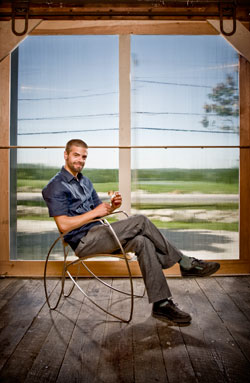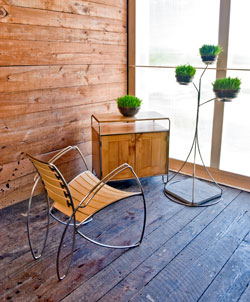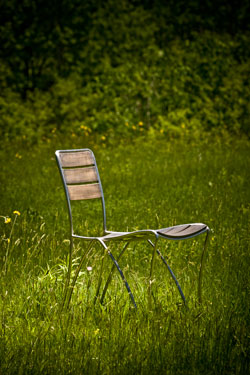The Futurist Obsessed with the Past
PROFILE – AUGUST 2008
By Joshua Bodwell
Photography Irvin Serrano
 a
A furniture maker focused on recycling and the cycle of life
Though we all are floating down life’s river, each of us must choose which shores to explore and how far upstream we dare venture. Some of us, however, might as well put the maps and compasses away—our journey has already been plotted. Take furniture artisan Eric Ritter, a young designer and craftsman who is every bit as old-fashioned as he is modern.

Ritter’s paternal grandfather was, not only a woodworker, but the kind of man who used a tool chest that had been handed down through his family since the 1870s. Ritter’s maternal grandfather was, not only an engineer, but the kind of man who, in retirement, handcrafted a full-sized and fully functional replica of a World War II–era German Stuka fighter plane from raw materials.
It seems that the 31-year-old Ritter was predestined from youth to weld together the passions of these two monumental figures in his life. That he has used their examples of craftsmanship and design to create Morphology, a line of outdoor furniture that gracefully joins stainless steel and wood, is a testament to Ritter’s own gifts as artist. And while some of his talents may be innate, he has worked hard to refine them.
A child of South Freeport, Ritter attended Gould Academy and took full advantage of the school’s well-equipped woodshop. Before he graduated in 1995, he had not only turned out metal and wood sculpture but had also built tables and cabinets. Ritter went on to study in the furniture department at the Rhode Island School of Design. “I’d always been interested in architecture and art, and how they work together in a physical space,” explains Ritter, “so furniture felt like a perfect blend between architecture and fine art.”
At RISD, Ritter’s courses often explored the purely sculptural aspects of furniture. His artistic urges, however, never wholly overwhelmed his practical mind, and he focused on designing chairs that were as utilitarian and they were gorgeous to behold. “I love chairs because they are really something you engage with, something your body forms to,” says Ritter.
Ritter graduated from design school in 2000 and settled in a decrepit circa-1790 New Gloucester farmhouse with his wife, Johanna Flath, a painter and art instructor. By this time, Ritter was already building prototypes for his Morphology line. With a patience he likely gleaned from his grandfathers, Ritter settled into his home, made major repairs, created a workshop in the attached barn, and made his living crafting custom cabinetry and furniture. For nine years, Ritter continued to distill his own designs and gently tweak them before finally launching Morphology last October.
The Morphology series feels at once modern and organic; it is an elegant and well-considered balance of stainless-steel frames coupled to wooden seats and backs. There are now four types of chairs, four tables, and three sizes of gently swirling plant stands.
At the heart of Ritter’s work is his belief in ecological design. During the evolution of the Morphology series, Ritter read Cradle to Cradle: Remaking the Way We Make Things by William McDonough and Michael Braungart. The book—which explores, among other things, waste-free production techniques—validated Ritter’s production ideals.
“I chose the stainless steel for several reasons,” explains Ritter. “First, it doesn’t require a toxic finish that would one day flake and damage the environment. Second, it is a 60 to 80 percent recycled material.” But Ritter has gone one step farther. While most materials, such as plastic or paper, decrease in quality as they are recycled, Ritter believes in the practice of upcycling—transforming a disposable or recycled material into something that is more valuable, useful, and long lasting. For the slats and seats of his chairs, Ritter slices hardwoods and laminates them back together into sumptuous curves using a process that requires no milling and creates very little waste. The finished wood is coated with only natural oils or stains.
Ritter’s shop—where he hand-bends each stainless-steel component and handles all the welding himself—is run by locally derived, emission-free electricity purchased through Maine Renewable Energy.
Some of Ritter’s new work is taking a more traditional approach to recycling by mixing stainless steel with reclaimed pine and fir. His newest dining table is topped with 200-year-old pine from a barn that was being torn down. “Look at this tight grain,” enthuses Ritter as he runs his hand along the top. “This is a beautiful relic from the past.”
When guests visit his shop and home, Ritter often leads them out the back door, saying mysteriously, “I’d like to show you my latest project…I’m really proud of it.” He wanders through the lush gardens, past half a dozen varieties of garlic and twice as many lettuces, but not all the way to his stacks of beehives, where he extracts beeswax to rub on stainless steel and wood. When he reaches a ramshackle construction of old pallets, he stops.
“This is my compost bin,” says Ritter proudly. “This pretty much says it all about what I’m trying to do.” It’s easy to see that if he weren’t weaving steel and wood together into stylish, comfortable furniture, Ritter could be a farmer happily following the seasonal cycle of life. “My work is always referring to circles, loops, and continuous lines. I love that philosophy,” he says with a smile. He is a futurist obsessed with the past.
 Ritter’s New Gloucester home is fertile land for furniture makers. Thomas Moser got started in this neck of the woods, and C. H. Becksvoort, the master of Shaker furniture, still works just down the road. But Ritter has thrown away the maps and is charting his own course. And if he needs inspiration, he has plenty of it close to home: there is his paternal grandfather’s tool chest at one end of the shop, and a tassel from a World War I German officer’s uniform, which once belonged to his maternal grandfather, hangs on a nail at the other end.
Ritter’s New Gloucester home is fertile land for furniture makers. Thomas Moser got started in this neck of the woods, and C. H. Becksvoort, the master of Shaker furniture, still works just down the road. But Ritter has thrown away the maps and is charting his own course. And if he needs inspiration, he has plenty of it close to home: there is his paternal grandfather’s tool chest at one end of the shop, and a tassel from a World War I German officer’s uniform, which once belonged to his maternal grandfather, hangs on a nail at the other end.